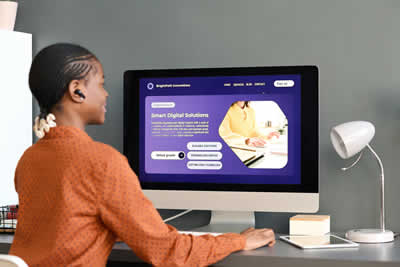These terms are often bandied about and people frequently just glaze over. Well, they’re simple enough to define.
The UI is the
user interface and it’s the visual elements, like the buttons, icons, and page layouts. It’s what people use to engage with an app or website page.
The UX is the
user experience, which is how the user feels about how they’ve interacted.
When planning an interface, designers aim for both – easy-to-use screens that gives people what they want, and this creates a great user experience.
That's why both are critical components of success. A well-thought-out UX/UI will create a lot more interaction – and sales – than one that’s been put together without the necessary attention. And with so many alternatives available to customers, this is more important than ever.

Some knowledge of human psychology is helpful for creating effective designs. By looking at consumer motivations, behaviors, and emotions, designers are able to create interfaces that address users' needs effectively. The results is that users – i.e. potential customers – are satisfied and motivated to buy. If not, they’ll often go elsewhere … so this is more than just a “nice-to-have” feature.
In this article, we’re taking a look at the psychological concepts that guide successful UX/UI design. This will result in interfaces that aren't only useful but also appealing, fulfilling – and motivational.
The Key Is Empathy
The
all-embracing foundation of UX/UI design is empathy. This means that designers need to see everything from the perspective of the user. They need to understand their objectives, problems, and the environment in which people use the product they’re thinking of buying. Designers are then able to meet their needs by developing intuitive and user-friendly interfaces.
Take a look at a mobile banking app for instance. Recognizing that users are often pressed for time when using the app, top priority can be given to features that allow for fast and simple access to popular screens (Like the ability to check balances and make transfers.) In addition, the prominent display of strong security features will give the user the confidence they need to trust the app.

Preconceptions
Users' internal ideas of how a system or product should work are called mental models. And it’s the goal of designers to make interfaces that fit into these mental models. If they do this, there’s less confusion and it’s easier for users to look at the product.
Designers can watch and speak to people to get an insight into their preconceptions. They may be able to learn about consumers' ideas regarding the product and its functionality by asking them what they expect, and what they’ve experienced in the past. This information is often very useful in guiding further development of the design.
User Testing
An essential stage in the design process is user testing. This will show up usability problems, and also get feedback by watching people using prototypes in a controlled environment.
Prototype testing is invaluable in making sure that the design is user-friendly, as well as showing ways to improve it.
This information will then be used to take the interface to a higher level.
Iterative Design
The process of designing UX/UI is iterative, which means continuously improving the interface. So it’s not just one prototype that’s used. When the results of the initial test are back, improvements are made and it’s tested again. This cycle is repeated, until the prototype is at the stage where the required quality (or maybe the budget…) has been reached.
As you can imagine, by using an iterative process, the final result will be best suited to deal with user preferences.
 Designing with iteration
Designing with iteration is also useful because technology – and expectations – rapidly evolves. And with a developed prototype as a model, adjustments can be made to adapt to these changes.
Affordances
An affordance is people’s implicit understanding of how to
interact with an object. With interface design, it refers to how people expect to interact with something. Text that is underlined will suggest a clickable link to another page (there are a few on this page, you’ll notice).
Similarly, the design and positioning of a button should suggest that it can be clicked. Likewise, a slider that appears to be movable implies that it may be moved. In this way, the design will lead users to interact with the interface quickly and naturally.
Consistency
It’s also essential for the interface to be consistent. Simple examples are the same fonts, colors, and layout themes to be used on different screens. This makes users comfortable, and improves their experience.
The words, structure and style used must also be consistent, because it makes things easier to understand and helps users stay clear of misunderstandings. And of course, it also contributes to the development of a unified and polished brand image.
Conclusion
There you have it, then! A quick examination of the psychology of UX/UI design. When designers understand these principles, they’ll avoid clumsy interfaces and motivate users to engage – and respond. Which is what it’s all about....


























